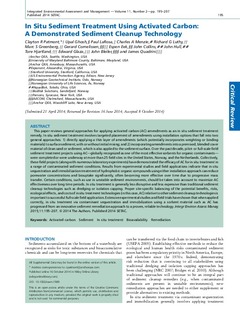| dc.description.abstract | This paper reviews general approaches for applying activated carbon (AC) amendments as an in situ sediment treatment remedy. In situ sediment treatment involves targeted placement of amendments using installation options that fall into two general approaches: 1) directly applying a thin layer of amendments (which potentially incorporates weighting or binding materials) to surface sediment, with or without initial mixing; and 2) incorporating amendments into a premixed, blended cover material of clean sand or sediment, which is also applied to the sediment surface. Over the past decade, pilot- or full-scale field sediment treatment projects using AC—globally recognized as one of the most effective sorbents for organic contaminants—were completed or were underway at more than 25 field sites in the United States, Norway, and the Netherlands. Collectively, these field projects (along with numerous laboratory experiments) have demonstrated the efficacy of AC for in situ treatment in a range of contaminated sediment conditions. Results from experimental studies and field applications indicate that in situ sequestration and immobilization treatment of hydrophobic organic compounds using either installation approach can reduce porewater concentrations and biouptake significantly, often becoming more effective over time due to progressive mass transfer. Certain conditions, such as use in unstable sediment environments, should be taken into account to maximize AC effectiveness over long time periods. In situ treatment is generally less disruptive and less expensive than traditional sediment cleanup technologies such as dredging or isolation capping. Proper site-specific balancing of the potential benefits, risks, ecological effects, and costs of in situ treatment technologies (in this case, AC) relative to other sediment cleanup technologies is important to successful full-scale field application. Extensive experimental studies and field trials have shown that when applied correctly, in situ treatment via contaminant sequestration and immobilization using a sorbent material such as AC has progressed from an innovative sediment remediation approach to a proven, reliable technology. | nb_NO |

